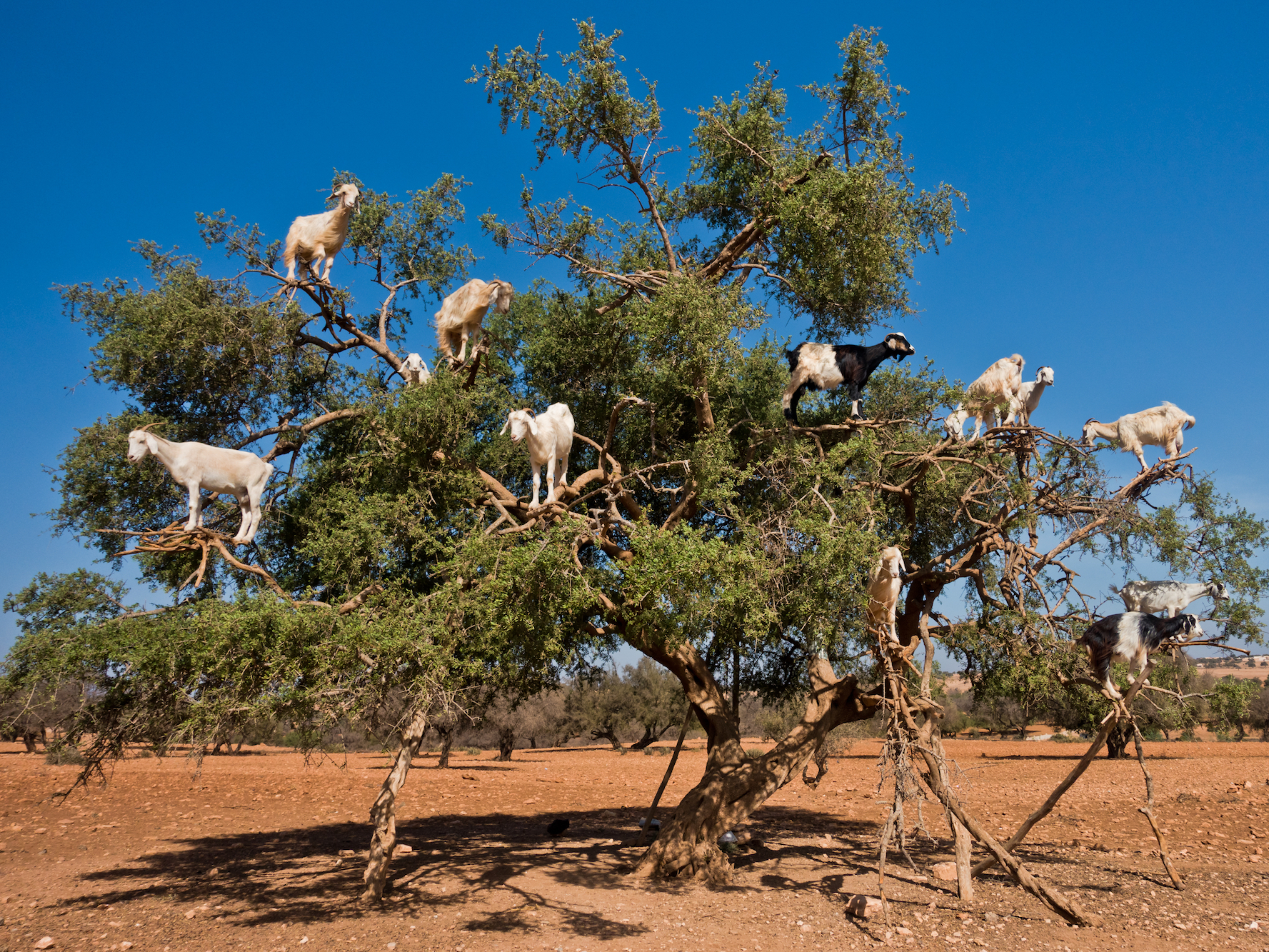- Goats can often be seen standing in the trees of Morocco’s Souss Valley. But according to Aaron Gekoski, a British environmentalist and photojournalist, some of the tree-dwelling animals might actually be a hoax.
- The environmentalist recently told the Telegraph that he believes some local farmers lure the animals into tall trees to attract tourists, who are often charged to take photos of the animals.
- Gekoski believes that the animals are unhealthy, and are harmful to the endangered Argania spinosa trees they climb. His observations come from an investigation that’s part of his campaign to end wildlife tourism.
- Goats in Morocco do climb trees naturally, and help to create argan oil in the process – they eat the trees’ fruit, and then release nuts through their waste. However, Gekoski believes that argan oil harvested by Moroccan locals is more ethical.
- Visit INSIDER’s homepage for more stories.
For some tourists, a trip to Morocco isn’t complete without visiting the country’s tree-dwelling goats. But, according to one environmentalist, the tourist attraction that’s found in the country’s Souss Valley near the southern city of Taroudant isn’t all that it might seem to be in photos.
British environmentalist and photojournalist Aaron Gekoski recently told the Telegraph that he believes some farmers in Morocco forcefully place goats within trees to attract tourists. According to the environmentalist, farmers charge tourists to take photos of the animals.
Gekoski’s observations come from an investigation that’s part of his campaign to end wildlife tourism, according to the Telegraph.

Some Moroccan farmers are said to be tying goats to trees to attract tourists
Gekoski believes the animals have been used by farmers to trick tourists and create a profit.
"After seeing tourists' interest in the tree-dwelling goats, some opportunistic farmers decide to manipulate the situation for financial gain," he told the Telegraph. Gekoski claims that farmers bring goats from other areas of Morocco, and then have them walk up "built platforms in the trees" to lure the animals onto branches.
"[Farmers] will take the goats home in the late afternoon, before coaxing them back into the trees at sunrise," Gekoski said.

Though the goats are "often rotated halfway through the day as they get tired," according to Gekoski, some of the animals do not appear to be healthy.
"The goats are incredibly nimble and dexterous when it comes to navigating the trees, though generally they just stand in one place, looking rather sick and forlorn," Gekoski said.
"It's incredibly hot work standing in a tree all day, and generally the goats are in poor condition and very skinny," he continued. "There were also almost no older goats, which I heard get eaten."

Read more: 15 places around the world that are being ruined by tourism
Goats in this part of Morocco commonly climb Argania spinosa trees (or argan trees) to munch on Argan fruit
Argan trees are found primarily in the Souss Valley, according to Culture Trip. Each year, the trees bloom with small yellow flowers, according to Culture Trip, which then produce fruit seeds within yellow nuts. While humans may not eat the fruit, goats in Morocco are said to love it. They're attracted to the fruit's pulp, and climb up to the top of argan trees to eat it.
Culture Trip describes the fruit as "a meal that [goats] both enjoy and do not need to compete for," especially because food in the area can be difficult for animals to come by.

And though the goats don't know it, their diet helps contribute to the production of Argan oil. According to Culture Trip, the goats eat nuts from the argan fruit but cannot digest them, leaving them in their waste. Local farmers can the nuts, and press them to produce argan oil. The finished product can retail for up to $20 for 150 milliliters.
Some argan-oil farmers are even said to keep goats away from the trees to prevent them from eating the growing fruit, which can take a year to fully ripen.

But tourists might not be fully aware of the nature of the tree-dwelling goats they see
While tourists might have some understanding of why the goats climb trees, Gekoski isn't sure that this is always the case. The environmentalist said that tourists he has encountered in Morocco seemed unaware that some goats may not do so voluntarily.
"All the tourists who visited seemed blissfully unaware," Gekoski told the Telegraph, adding that they "'oohed' and 'ahhed' before taking photos and selfies."
He said taking photos with the goats seem to be encouraged.
Not only can visitors take photos in front of the trees, but "farmers will also hand over young goats, known as kids, for photo opportunities," Gekoski said.

Goats in the area contribute to the production of argan oil, but it can also be created without the help of the animals
According to Argan Farm, a blog about argan oil, Moroccan locals are known to collect argan fruit that's fallen from trees. From there, they can dry the fruit's pulp in open air, and then extract argan oil.
Gekoski mentioned these local workers while speaking with the Telegraph, and said he believes that tourists should purchase argan oil from Moroccan residents.
"Elsewhere in Morocco, women will harvest Argan oil by hand, which is more ethical and environmentally friendly," Gekoski said.
Argan trees might be in danger as a result of too many goats living in the area, too. According to Culture Trip, farmers have brought large numbers of goats into the area in recent years to appease the influx of tourists who visit annually.
And because argan fruit is not typically ripe during Morocco's busiest tourist seasons - between the months of April and May, as well as September to November, according to TripSavvy - large numbers of goats are said to be placed into barren trees by farmers, which can weigh down and break branches. Goats will also eat fruit that's not yet ripe, which can stunt the growth of the trees.
The argan tree is now considered endangered by the World Wildlife Fund, and the forest in which they're located is currently protected by UNESCO.
- Read more:
- A young humpback whale was found dead and tangled in rope on a beach in Scotland
- A great white shark was found tangled in a net after a fisherman said it choked on a turtle
- A police dog was stuck with 200 porcupine quills during the pursuit of a suspect
- Engineers found an owl napping inside the engine of a Virgin Australia plane

